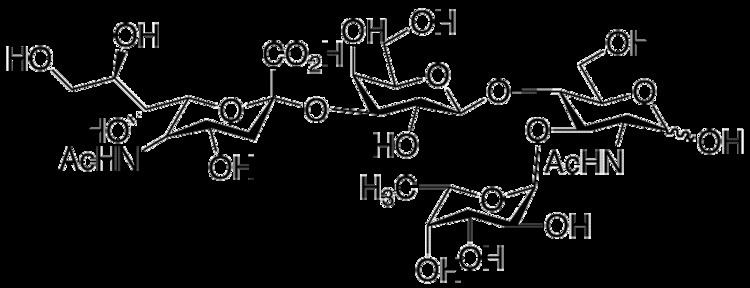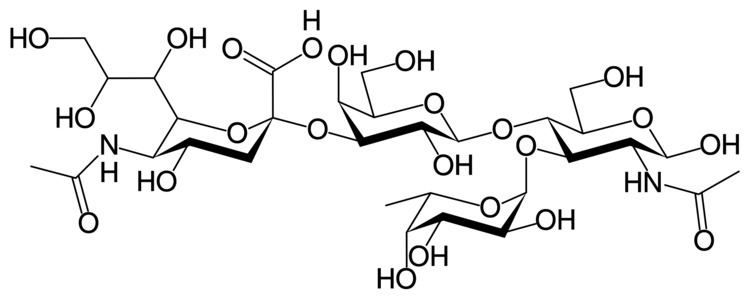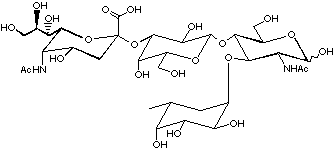Formula C31H52N2O23 | Molar mass 820.744 g/mol | |
 | ||
Sialyl LewisX, also known as sialyl LeX and SLeX, is a tetrasaccharide carbohydrate that is usually attached to O-glycans on the surface of cells. It is known to play a vital role in cell-to-cell recognition processes. It is also the means by which an egg attracts sperm; first, to stick to it, then bond with it and eventually form a zygote. The discovery of the essential role that this tetrasaccharide plays in the fertilization process was reported in August 2011.
Contents

Sialyl Lewis X is also one of the most important blood group antigens and is displayed on the terminus of glycolipids that are present on the cell surface. The sialyl Lewis X determinant, E-selectin ligand carbohydrate structure, is constitutively expressed on granulocytes and monocytes and mediates inflammatory extravasation of these cells. Resting T- and B-lymphocytes lack its expression and are induced to strongly express sialyl Lewis X upon activation. The sialyl Lewis X determinant is expressed preferentially on activated Th1 cells but not on Th2 cells.

History

The term Lewis in its name comes from the name of a family of people who suffered from a red blood cell incompatibility. The studies done on these individuals’ red blood cells led to the discovery of sialyl Lewis x. Sialyl Lewis x is a very important red blood cell antigen present on the glycolipids on the plasma membrane of the cell.
Clinical significance

Defective synthesis of the sialyl Lewis X antigen results in immunodeficiency (leukocyte adhesion deficiency type 2). Defective synthesis can be caused by the loss of fucosyltransferase, impairing the glycosylation of the glycosphingolipid.

Sialyl Lewis x is being used in studies to fight tumors and cancer cell growth. It has been shown that there is frequent overexpression of sialyl Lewis x on cancer cells and is found on both N-glycan and O-glycans. Sialyl Lewis x is being researched with CD markers to find new ways to create biosensors for cancer cells. Also, it is being used in new ways to target cancer cells specifically for cancer treatment.

It is also being used to achieve greater rates of fertilization of eggs in women by coating the eggs with sialyl Lewis x. It plays a key role in the inflammatory response and may be used to increase the leukocyte response to infections.
Sialyl Lewis x is an inflammation-associated antigen on liver cells. It becomes over expressed on diseased liver cells and can be used as a way to detect liver disease in a patient.
Sialyl Lewis x is also being researched for detection and treatment of immune disorders because of its presence on leukocytes. There is congenital disorder where there is an inclination to recurring severe infections. This stems from an absence of sialyl Lewis x attached to E-selectin ligands on their neutrophils.
Leukocyte homing and cancer metastasis
Sialyl-Lewisx is important in leukocyte tethering and rolling. Leukocytes move through the blood stream and then tether themselves to the endothelial wall and roll along the endothelial tissue to determine if they want to leave the bloodstream to get to necessary tissue.
Sialyl-Lewisx is a necessary partner for the three selectins that bind the leukocyte and endothelial cells. When sialyl-Lewisx is part of an O-glycan and attached to CD34 it can then bind to L-selectin. For the binding to L-selectin to occur sialyl-Lewisx must undergo sulfation. For sialyl-Lewisx to attach to P-selectin it must bind to P-Selectin Glycoprotein Ligand-1 (PSGL-1) first which is then sulfated allowing sialyl-Lewisx to attach to P-selectin. For sialyl-Lewisx to bind to E-selectin it needs to be part of an N-glycan and then bind to CD44 or possibly glycolipids which have also been implicated to assist in binding. This binding allows the leukocytes to stick to and be released from the endothelial cells as needed to reach their destination.
Sialyl-Lewisx also plays a critical role in cancer metastasis, facilitating the extravasation of cancer cells out of the bloodstream while they are moving through the body.
Human fertilization
Sialyl-Lewisx allows a sperm cell to recognize and fertilize an egg cell. For fertilization to occur, human sperm must bind to the zona pellucida (ZP), the translucent matrix covering the human egg composed of four glycoproteins ZP1, 2, 3, and 4, and transit through the matrix in order to fuse with the oocyte. Human ZP is coated with highly dense N- and O-glycans that are terminated with the sialyl-Lewisx sequence. The hemizona assay, which assesses sperm-ZP binding by counting the number of sperm bound to hemispheres of bisected nonliving human eggs in vitro, revealed that as little as 0.5 mM sialyl-Lewisx inhibits sperm-ZP binding by 63%. Furthermore, adding purified and solubilized ZP3 or ZP4 from the human oocyte dose-dependently inhibits sperm-ZP binding in the hemizona assay. Such evidence suggest that the early steps of human sperm-egg binding may be mediated by lectins for sialyl-Lewisx present on human sperm.
